Don't leave the Isles of Scilly without visiting Tresco Abbey Gardens- it really is something extremely special.
💜💙💛💚
Tresco is the second largest of the five inhabited isles of the Isles of Scilly, and is leased from the Duchy of Cornwall by the Dorrien-Smith family, who run it primarily as a holiday resort.
I've also created a You Tube vlog about the island, link:-
We took our 10.15am boat from St Mary's (the largest island in the archipelago, and our base for the week) and were deposited at New Grimsby Quay, and told we would be picked up at Carn Near Quay, which is to the south of the island. That was actually very convenient- the choice of quays (there are three in total- Old Grimsby Quay is on the other side of the island) is dependent on the tides, and Tresco Abbey Gardens sits right in between our two quays.
New Grimsby Quay, overlooking New Grimsby Sound.
Our walk took us past these stone monuments- the variety of scenery is the result of deformation till deposits occurring after the last ice age; 115,000-11,700 years ago.
We couldn't help but notice that the temperature appeared to be 10° warmer than it had been on St Mary's...
...This is the effect of the Gulf Stream, which creates a frost free environment, and the fact that Tresco is tucked in between St Martin's and Bryher, and therefore sheltered.
The Great Pool is one of two lakes on the island, and the geography definitely changes from rocky, to sparse, to fecund...
The island is car-free and is easy to walk, being only two-and-a-half miles long by one mile wide.
What looks like some kind of drainage grate or irrigation system...
Tresco was definitely the most verdant of the islands we visited...
Tresco Abbey, and we weren't allowed to wander in here as the Dorrien-Smiths still reside here.
The garden was created early in the 19th century by Augustus Smith, after he had taken over the lease of the islands in 1834. A man of independent means, he realised that the fantastic climate leant itself to the growing of an exotic garden that wouldn't be able to flourish on the British mainland.
It has been in the hands of this same family for five generations, with each generation making its contribution; be that corresponding with other influential gardeners from places such as Kew, or regeneration after events like the disastrous great storms of 1987 and 1990.
Abbey Pool...
The Valhalla Museum sits alongside the gardens and was purpose built in 1870 to house the collection of figureheads from the many wrecks around the islands.
Standing on the entrance bridge watching red squirrels feed. Red squirrels were introduced to the island in 2012.
Red squirrels are much rarer than grey. We saw evidence of many of the latter in the Morrab Gardens, Penzance.
They are not easy to photograph when they are darting around a tree trunk!😁
During our second visit to the gardens our little friends seemed much more abundant!
From this angle on the incline you can hardly see the Shell House, hidden behind this ornamental fountain.
A closer view and she looks quite serene!
The Shell House was designed by Lucy Dorrien-Smith, wife of Robert Dorrien-Smith, following the devastating great storm of 1987.
The hexagonal building contains native shells...
It brings to mind the shell grottoes in both Margate, Kent and A La Ronde, Exmouth.
Looking down past the Agave Fountain...
Looking through the greenery and out towards the sea...
You could be somewhere other than England, as plants from all over the temperate world feature within this space...
The elephant and fist represent the unusual family crest...
Front view of the little waterfall...
Stunning purple flowers, and this place really is a riot of colour and texture.
Middle Terrace nook...
Gazing up the Neptune Steps, and Neptune has sat here from 1841.
Neptune is actually the figurehead from SS Thames, a steamship wrecked in the area.
Arbour...
Black-eyed Susans forming a carpet in front of part of the Old Abbey, and it is around here that it's believed that Augustus Smith began his first careful planting.
Benedictine monks settled here between 1042 and 1066 and the priory is mentioned in an 1120 charter; at the time of Henry I (r.1100-1135).
This area was inaccessible, but to the right of the photo is what they call the shelter belt- hardy, salt-tolerant, quick-growing pines which protect the garden from winter gales.
The cube sculpture is by Newlyn-born artist Tom Leaper.
The Old Abbey, with Abbey Hill beyond.
The priory would have been totally abolished during the Dissolution of the Monasteries (1536-41) by Henry VIII.
The Tresco Children bronze sculpture is symbolic of the freedom of the Isles of Scilly, is by David Wynne and was unveiled by Princess Diana in 1991.
The children are Adam, Frances and Michael; the children of Robert and Emma Dorrien-Smith (the owner of Tresco Abbey and his former wife).
We stumbled across the well only on our second visit...
If you enlarge this photo you can see the SuperDean's face peering down into its depths...
😀
Giant trees and beautiful lawns made for a lovely place to sit awhile...
Vegetable Garden, with some massive pumpkins popping up at the back...
Chickens tucked away beneath fruit bushes...
The Roman Altar was originally found on the Garrison on St Mary's in the 1860s. The bowl on the top was added during Victorian times.
The Ancient Stone Seat...
We headed over to the Valhalla Museum- an open air collection of figureheads taken from shipwrecks.
The bronze gun is from the 1707 wreck of the Association.
Here we have an inquisitive SuperDean inspecting it!
This former cresset (a metal container used for illumination and containing lit oil, grease, coal or wood) was used at St Agnes Lighthouse.
Augustus Smith developed his collection of figureheads, which first sat on the Abbey terrace...
Figureheads are decorative carvings which sit on on the bows of ships.
The chap in the black jacket to the right is from the Palinurus, which was wrecked off St Martin's in 1848. All of the 17-strong crew drowned.
Their meaning is unclear, but the fact that these come from wrecks is a sad reminder of lives lost, and the power of the sea.
There are 28 figureheads here, and they date from the latter half of the nineteenth century...
The colourful "segment" in the middle was my favourite...
The figureheads are both beautiful and evocative.
The lady with the green sash is the figurehead from the Serca, wrecked off St Mary's in 1893.
These beautiful, tropical flowers with heavy petals are called aeonium arboreum 'zwartkop' (the word means black head, in Dutch). We also had little friends on our table outside the café.💜
Little birds fly around both inside and out all over the Isles of Scilly (there was one hopping around the indoor part of this café, and I saw more in the waiting room at St Mary's quay.) I've no idea what they are- some species of sparrow, tit or martin, maybe?
Looking up through the Mediterranean Garden to the Shell House...
The Agave Fountain sculpture is another piece by Tom Leaper...
Gaia, Mother Earth is another David Wynne sculpture, and dates from 1990.
I loved the way lichen has taken over this seat...
Walking across the airfield and heliport...
About 150 people permanently live on Tresco, although that raises in the summer due to seasonal staff.
Looking out over the rugged-yet-picturesque vista...
Carn Near Quay slipway with St Martin's over the water...
Tresco Abbey Gardens, you were wonderful and I shall return...
Until then...
TTFN
The Miss Elaineous
xxxxxxxxxx
xxxxx
x

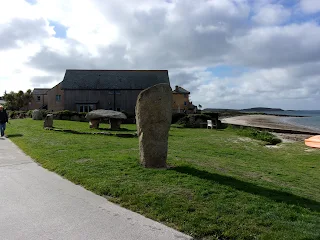




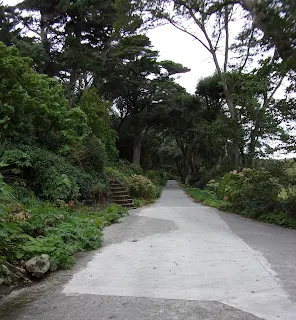





















.JPG)













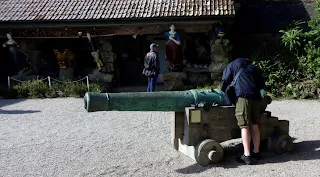



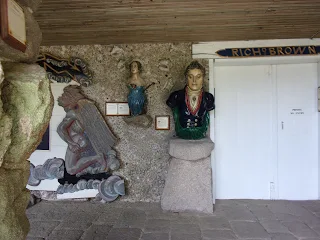




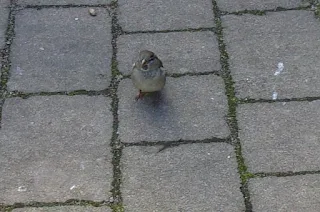





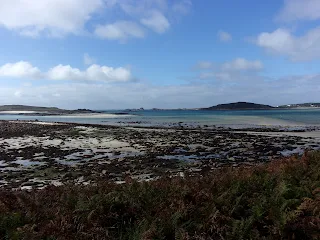

No comments:
Post a Comment